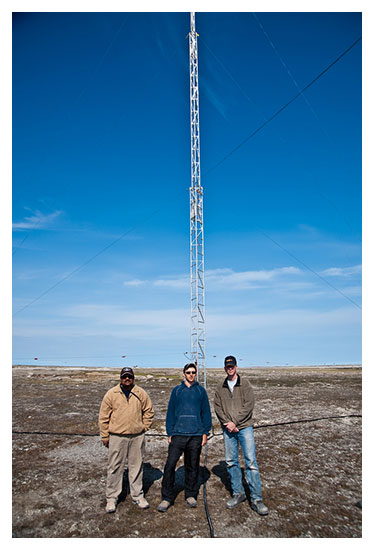UNB physicists help Government of Canada improve arctic communications
Author: UNB Newsroom
Posted on Nov 14, 2018
Category: UNB Fredericton
 Physicists from the University of New Brunswick’s Radio Physics Lab have developed a new model that will help Canada monitor activity in the arctic and improve arctic communications.
Physicists from the University of New Brunswick’s Radio Physics Lab have developed a new model that will help Canada monitor activity in the arctic and improve arctic communications.
The Empirical Canadian High Arctic Ionospheric Model (E-CHAIM) is the first phase of the UNB Radio Physics Lab’s $1.2-million All Domain Situational Awareness Program contract with Defence Research and Development Canada. Dr. P. T. Jayachandran, UNB physics professor and principal investigator for the Canadian High-Arctic Ionospheric Network, is leading the project. Dr. David Themens, who was a graduate student at the physics department of UNB, is leading the development of the model.
“Due to the receding and thinning of arctic sea ice, the arctic has become more accessible year-round,” says Dr. Jayachandran. “This accessibility has caused an increase in commercial, industrial, and defence traffic. But disturbances in the ionosphere can cause flights to be re-routed and can inhibit proposed radar systems that would monitor this traffic.”
The ionosphere, an ionized layer of the earth’s upper atmosphere, facilitates high frequency communications. “But like weather on land,” says Dr. Themens, “the ionosphere experiences ‘space weather’, which changes significantly from day-to-day. This weather makes ionospheric modeling a challenging endeavour.”
Space weather can cause significant disruptions to high frequency radio transmission, global positioning systems, and navigation technologies. Aircraft re-routes and other costly service disruptions occur regularly because of ionospheric disturbances. The ionosphere also facilitates the use of long-range communications and early warning radar systems, but poor modeling in the past has limited the deployment of these technologies and prevented their use in the Canadian Arctic.
If successful, E-CHAIM will provide users with significantly improved high arctic communication and monitoring capabilities and will act as an integral tool for designing future high frequency communications and radar systems. For the two remaining phases of the contract, the UNB Radio Physics Lab will develop a sophisticated data assimilation system capable of capturing space weather impacts on the ionosphere using similar techniques to those used by meteorologists around the world.
Media contact: Hilary Creamer Robinson
Photo: UNB CHAIN researchers Dr. P. T. Jayachandran, Chris Watson and Todd Kelly in Hall Beach, Nunavut. Credit: Richard Chadwick
